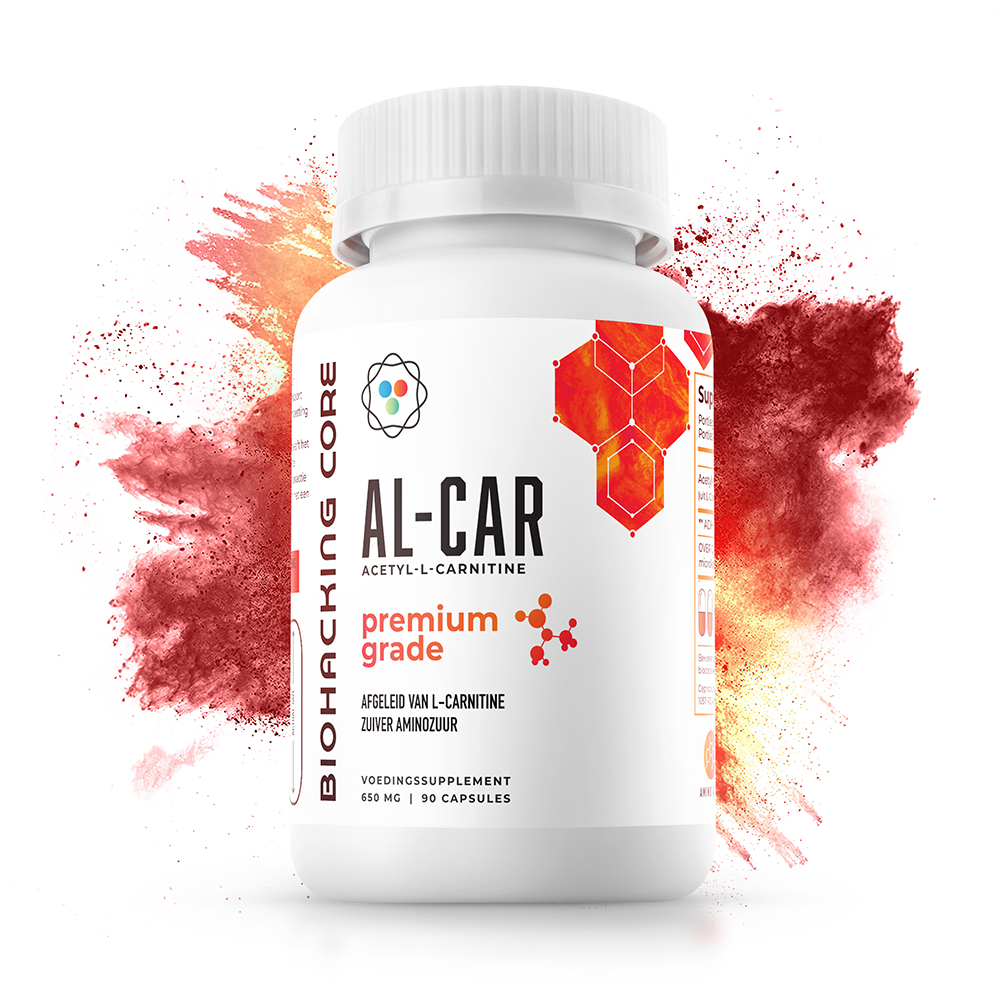

Acetyl-L-Carnitine
- Category: Amino acids
Quantity
| Quantity | Discounted price | DISCOUNT |
|---|---|---|
| 3-5 | €21.80 | 5%€1.15 |
| 6-9 | €21.11 | 8%€1.84 |
| 10+ | €20.65 | 10%€2.30 |
Change your country
- Your Biohacking Experts.
- Mo-Fr Same day shipping for orders before 17:00.
- Free shipping for orders above 75eu.
- Superior Quality high purity extracts and compunds.
- Quantity based discounts applicable.
Biohacking Core Acetyl L-Carnitine (ALCAR) 650mg Capsules
Product Overview
Biohacking Core offers Acetyl L-Carnitine (ALCAR), an acetylated form of the amino acid L-Carnitine, in a convenient capsule format. ALCAR occurs naturally in the body and is involved in cellular energy metabolism, particularly the transport of fatty acids into mitochondria. It also provides acetyl groups, which are used in the synthesis of the neurotransmitter acetylcholine.
This supplement provides a precise 650 mg dose of Acetyl L-Carnitine HCl per capsule, available exclusively in capsule form.
Key Features
- Provides 650 mg of Acetyl L-Carnitine HCl per capsule.
- Acetylated form of L-Carnitine.
* Involved in cellular energy metabolism and acetylcholine synthesis. * Convenient capsule form only. * Consistent dosage per capsule.
Ingredients & Supplement Facts
- Serving Size: 2 capsules
- Servings Per Container:
- Amount Per Serving:
- Acetyl L-Carnitine HCl: 1300 mg
- Other Ingredients:.
Suggested Use
Take 2 capsules one to two times daily with water, preferably with a meal, or as directed by a healthcare professional. Swallow capsules whole.
Quality & Purity Assurance
Biohacking Core is committed to quality. Our Acetyl L-Carnitine capsules are manufactured under controlled conditions to ensure product consistency and purity. Quality control procedures are implemented during production..
Packaging & Storage
- Packaging: capsules per plastic bottle, securely sealed.
- Storage: Keep in a cool, dry place. Keep the bottle tightly closed when not in use. Keep out of reach of children.
Warnings & Cautions
- For adult use only.
- Consult your healthcare provider before using this product if pregnant, nursing, taking medication (especially blood thinners), or have a medical condition (e.g., thyroid disorder, seizure disorder).
- Keep out of reach of children.
Disclaimer
This product is a dietary supplement and is not intended to diagnose, treat, cure, or prevent any disease. It should not be used as a substitute for a varied and balanced diet or a healthy lifestyle. Do not exceed the recommended daily dose.
Ingredient Overview
Acetyl-L-carnitine (ALCAR) is the acetylated form of L-carnitine, a naturally occurring amino acid derivative involved in energy metabolism12. In the body, L-carnitine is synthesized in the liver, kidneys, and brain from lysine and methionine, but under certain conditions (e.g. prematurity or renal disorders) it becomes a conditionally essential nutrient that must be obtained from the diet3. ALCAR is naturally produced in human tissues and is also available as a dietary supplement without prescription4. Unlike essential vitamins, the human body can endogenously produce L-carnitine, so ALCAR is not classified as a vitamin. It is sometimes informally referred to as a “vitamin-like” compound. ALCAR supplements are marketed for nutritional support, and this overview will discuss its chemistry, sources, biological roles, metabolism, production, and regulatory background.
Chemical Classification and Structure
Chemically, acetyl-L-carnitine is the O-acetyl ester of L-carnitine5. It is a small, water-soluble molecule with the molecular formula C9H17NO4 (base form) and is typically supplied as the stable hydrochloride salt (CAS 5080-50-2, C9H17NO4·HCl) for supplement use. Like L-carnitine, ALCAR contains a permanently charged quaternary ammonium group and a carboxylate group, making it a zwitterion at physiological pH6. This polarity contributes to its high water solubility7. Only the L-enantiomer is biologically active; the D-form of carnitine (or its esters) is not utilized by the body and can interfere with L-carnitine function8. The structural backbone of L-carnitine is β-hydroxy-γ-N-trimethylaminobutyric acid9. Acetyl-L-carnitine differs by having an acetyl group (CH3CO–) esterified to the hydroxyl moiety of L-carnitine. In solid form, ALCAR is a white crystalline powder; as a hydrochloride it is hygroscopic and highly soluble in water. Figure 1 (not shown) typically illustrates L-carnitine and its acylated derivatives, including acetyl-L-carnitine and propionyl-L-carnitine1011.
Dietary Sources
L-Carnitine (and by extension, acetyl-L-carnitine which can be formed from it) is naturally present in a variety of foods, predominantly those of animal origin. Red meats are the richest sources – for example, cooked beef steak provides around 80 mg of L-carnitine in a 3-ounce (~85 g) serving12. Pork contains roughly 20–25 mg in the same serving size, and foods like cod fish and chicken breast supply smaller amounts (on the order of 3–5 mg per 3 oz)13. Dairy products like whole milk (~8 mg per cup) and cheese (1–2 mg per serving) contribute modest carnitine, whereas most fruits, vegetables, and grains have only trace levels (<1 mg per serving)14. Because of this distribution, omnivorous diets typically provide an estimated 24–145 mg of carnitine per day, whereas strict vegan diets (with few animal products) may provide as little as ~1 mg per day15. However, healthy humans can biosynthesize roughly 15 mg of L-carnitine per day endogenously to help meet needs16. Infant nutrition is a special case: human milk contains L-carnitine, and non-milk infant formulas are fortified to ~11 mg/L to ensure adequate carnitine for infants who cannot yet synthesize enough17. In adults, endogenous synthesis and efficient renal conservation of carnitine help maintain body levels even with low dietary intake, so deficiency from diet alone is rare in the general population. Still, dietary ALCAR from foods is possible in minor amounts – some acetylated carnitine may naturally occur in animal tissues – but intake is predominantly in the form of free L-carnitine, which the body can convert to acetyl-L-carnitine as needed.
Biochemical Role and Presence in the Body
L-Carnitine and its acyl esters (including acetyl-L-carnitine) play a crucial biochemical role in energy production. Carnitine’s primary function is to facilitate the transport of long-chain fatty acids into the mitochondria for β-oxidation (fat breakdown) and ATP generation1819. In this “carnitine shuttle” mechanism, fatty acyl groups (such as palmitoyl-CoA) are transferred to carnitine via carnitine palmitoyltransferase I (CPT I) on the outer mitochondrial membrane, forming acyl-carnitines20. The acyl-carnitine is then translocated into the mitochondrial matrix by a specific transporter, and CPT II reconverts it to acyl-CoA inside, releasing free carnitine2122. Acetyl-L-carnitine is a short-chain acyl-carnitine; it can be formed by the enzyme carnitine acetyltransferase, which reversibly combines carnitine with acetyl-CoA. This reaction serves to buffer the acetyl-CoA/CoA ratio in mitochondria and also enables export of excess acetyl units out of mitochondria as acetylcarnitine23.
ALCAR can freely cross cell membranes and even the blood-brain barrier, and once in the cytosol it may be converted back to acetyl-CoA and carnitine by cytosolic carnitine acetyltransferase, thereby donating acetyl groups for various metabolic needs. In addition to its role in fatty acid oxidation, acetyl-L-carnitine provides acetyl groups for other biochemical processes. Notably, ALCAR can donate its acetyl moiety for the synthesis of acetylcholine, an important neurotransmitter, in the central and peripheral nervous system24. This means ALCAR serves as a reservoir of acetyl units that can support neurotransmitter production and other acetylation reactions in cells. ALCAR and other carnitine esters also help in detoxification of acyl residues – for example, they assist in removing excess acyl-CoA groups that could accumulate and disrupt metabolism25.
Distribution in the body: Carnitine is highly concentrated in tissues that use fatty acids as fuel. About 95% of total body carnitine is stored intracellularly in skeletal muscle and cardiac muscle2627. These muscles contain carnitine at levels many times higher than in blood. The liver and kidneys also contain smaller carnitine pools, and only about 0.5% of the body’s carnitine is present in the bloodstream at any time28. Acetyl-L-carnitine is one of the predominant acyl-carnitine species found in tissues and plasma, reflecting its role in intermediary metabolism. In fact, blood plasma normally contains a mix of free carnitine and short-chain acyl-carnitines (like acetyl-L-carnitine), with the ratio of acylated to free carnitine varying with metabolic state29. Tissues such as brain and nerves also contain acetyl-L-carnitine, which, due to its ability to cross the blood-brain barrier, is thought to support energy metabolism in neural tissue30. The body maintains carnitine homeostasis through a combination of dietary absorption, endogenous synthesis, and efficient renal reabsorption of filtered carnitine3132.
Metabolism and Excretion
When acetyl-L-carnitine is absorbed (e.g., from a supplement), it enters the bloodstream and can be utilized or broken down. ALCAR is hydrolyzed by ubiquitous esterase enzymes in blood and tissues, yielding free L-carnitine and an acetyl group33. The liberated carnitine is then available to participate in the carnitine shuttle or other functions, while the acetyl group can enter metabolic pathways (often by forming acetyl-CoA). This hydrolysis is efficient – orally administered acetyl-L-carnitine has been shown to rapidly increase blood carnitine levels, indicating that much of it is converted to carnitine in vivo34. Some acetyl-L-carnitine may reach tissues intact; cells can take up ALCAR via organic cation transporters similar to those for carnitine35. Inside cells, acetyl-L-carnitine and carnitine are interconverted by the enzyme carnitine acetyltransferase, allowing the cell to either produce ALCAR (by acetylating carnitine using acetyl-CoA) or to generate acetyl-CoA from ALCAR as needed3637. This reversible reaction is important in muscle (including heart muscle) and in the mitochondria of many tissues, as it helps to regulate the acetyl-CoA pool and energy production3839.
Excess carnitine and acyl-carnitines are excreted primarily via the kidneys. Normally, the renal tubules reabsorb the majority of filtered carnitine, so only a small fraction is lost in urine40. When blood levels are high (e.g., after large supplemental doses), the reabsorption mechanisms can saturate, and more carnitine and acetyl-L-carnitine are excreted. Carnitine that is not absorbed from the intestine can be metabolized by gut microbiota. Colon bacteria can convert carnitine and acetylcarnitine into trimethylamine (TMA), a volatile compound. The liver then oxidizes TMA to trimethylamine-N-oxide (TMAO)4142. Research has found that high levels of dietary carnitine can lead to increased TMAO production, especially in omnivores with certain gut bacteria profiles43. TMAO has been statistically associated with cardiovascular risks such as atherosclerosis in some studies44. For instance, a 2013 study showed that omnivorous subjects produced more TMAO from carnitine than vegetarians, linking gut microbial metabolism of carnitine to atherosclerotic markers4546. However, the long-term health implications of this pathway are still under investigation; factors like gut microbiome composition and diet modulate TMAO levels, and causal relationships to disease remain to be fully clarified47. From a metabolic perspective, TMAO formation is one pathway for carnitine disposal when intake exceeds immediate needs. Apart from TMAO, the main excreted forms of carnitine are free carnitine and short-chain acyl-carnitines (like acetyl-L-carnitine) in urine48. No significant accumulation of acetyl-L-carnitine occurs in the body beyond what is buffered in the carnitine pool; surplus amounts are either utilized, converted, or excreted.
Industrial Production Methods
Acetyl-L-carnitine used in supplements is produced industrially, often starting from L-carnitine itself. L-Carnitine can be manufactured by several methods. Traditional chemical synthesis involves multi-step organic reactions (for example, using substrates like epichlorohydrin or γ-butyrobetaine) to produce a racemic mixture, followed by resolution to obtain pure L-carnitine49. More modern processes use biotechnological methods: certain microorganisms (such as specialized strains of Escherichia coli or Proteus) can produce L-carnitine via fermentation when provided with suitable precursors (e.g., crotonobetaine or other intermediates). Enzymatic biosynthesis methods have also been developed, including asymmetric synthesis using enzymes or engineered microbes that yield exclusively L-carnitine50. Major manufacturers employ proprietary processes; for instance, Lonza’s “Carnipure” process is a fully synthetic pathway that directly produces L-carnitine in the L-(+)-form, whereas other companies use fermentation or enzymatic steps.
Once L-carnitine is obtained, acetyl-L-carnitine is produced by a simple acetylation reaction – essentially attaching an acetyl group to L-carnitine. In practice, this is achieved by reacting L-carnitine (often as a free base or as L-carnitine inner salt) with an acetylating agent such as acetic anhydride or acetyl chloride51. The reaction yields acetyl-L-carnitine, which is typically isolated as the hydrochloride salt (to improve stability and purity). According to technical literature, the acetylation of L-carnitine is a straightforward chemical process and results in the same product that is naturally formed in the body52. Manufacturers ensure the final product is the L-isomer; any D-carnitine impurity is undesirable due to safety concerns. The final ALCAR HCl is highly water-soluble and is used in various supplement forms (capsules, powders, liquids). Industrial quality control includes confirming identity (by techniques like HPLC or NMR) and purity (often ≥98% ALCAR). Some supplement-grade ALCAR is produced under pharmaceutical GMP standards, reflecting its use in clinical nutrition. Overall, whether via chemical synthesis or biotech fermentation, large-scale production of carnitine and its esters is well-established, and acetyl-L-carnitine has been manufactured for decades. (Notably, the compound was first synthesized and characterized in the 1950s, after L-carnitine itself was isolated from meat in 190553.)
Regulatory and Historical Background
Historical background: L-Carnitine was first isolated from animal muscle (meat extracts) in 1905 and its structure determined by 192754. Its name is derived from “carnus,” the Latin word for meat, reflecting its source. Early on, carnitine was investigated as a potential vitamin – it was once termed “vitamin BT” because it appeared essential for growth in certain insects (mealworms)55. However, it became clear that humans and other higher animals can synthesize carnitine, so it is not a true vitamin for us56. Scientific interest in carnitine grew in the 1960s–1970s as its role in fatty acid metabolism and heart muscle function was elucidated. Acetyl-L-carnitine, as a naturally occurring derivative, was studied in the 1980s and beyond for its metabolic and neurological roles. By the late 20th century, both L-carnitine and acetyl-L-carnitine were being used therapeutically in certain contexts and sold as supplements.
Safety and Recommended Dosages
Acetyl-L-carnitine is generally considered safe and well-tolerated when used at common supplemental dosages. There is no officially established tolerable upper intake level (UL) for carnitine from food or supplements62. In clinical studies and risk assessments, chronic intakes up to about 2,000 mg (2 g) per day of L-carnitine (or equivalent carnitine derivatives) have shown no serious adverse effects63. Supplemental ALCAR is typically taken in doses of 500–1,500 mg per day, often divided into two or three doses. Many supplement manufacturers and nutritionists recommend around 1 g per day as a safe and adequate amount for general use64. The Linus Pauling Institute, for example, suggests 0.5–1 gram of acetyl-L-carnitine daily for adults who choose to take carnitine supplements65. In clinical trials, higher doses (2–3 g/day of ALCAR or L-carnitine) have been used for specific purposes, but with diminishing absorption efficiency and a greater likelihood of side effects6667.
At typical doses (≤2 g/day), side effects are uncommon. Known side effects: The most frequently reported mild side effects of carnitine supplements are gastrointestinal. Some individuals experience nausea, vomiting, abdominal cramps, or diarrhea with higher doses of ALCAR or L-carnitine68. These effects are dose-dependent and often resolve if the dose is reduced. A well-known benign side effect of high-dose carnitine supplementation is the development of a “fishy” body odor69. This odor is caused by trimethylamine accumulation (a metabolic byproduct) and tends to occur when intake exceeds about 3 g per day70. Acetyl-L-carnitine specifically has occasionally been noted to cause agitation or restlessness in patients with Alzheimer’s disease or other cognitive disorders in some reports71. This effect is not common, but caregivers and clinicians have observed increased agitation in a subset of dementia patients taking ALCAR, leading to caution in that population.
Importantly, only the L-form of carnitine is safe; supplements should contain L-carnitine or L-ACAR exclusively. D-carnitine (the mirror-image isomer) is not utilized by the body and can actually inhibit carnitine-dependent processes, potentially leading to muscle weakness or other problems72. Commercial products today overwhelmingly use the L-form, and any mixture with D-carnitine is avoided due to these safety concerns.
Metabolic and long-term safety: As discussed, carnitine supplementation can elevate TMAO levels in some people, which has spurred debate about long-term cardiovascular safety. Current evidence is inconclusive – while omnivores taking high-dose carnitine may see a rise in TMAO (a compound linked to atherosclerosis)7374, no direct causal harm from carnitine supplements has been confirmed. Moderation and a balanced diet are advised. A 2020 systematic review of L-carnitine in healthy adults found no serious adverse effects in studies up to 6 months long, aside from the mild effects noted above75. In fact, the review reinforced that carnitine has a strong safety profile at doses of 1–4 g/day used in research7677. Carnitine is naturally present in the body, and surplus amounts are efficiently excreted if not needed, which contributes to its safety.
One area of caution is use in individuals with seizure disorders. There have been case reports suggesting carnitine could worsen seizures in people with epilepsy. However, a comprehensive review (2016) found no evidence that levocarnitine supplementation increases seizure frequency in patients on anti-epileptic drugs78. In fact, that review debunked earlier worries by showing no clear association between carnitine and seizures7980. Nonetheless, it is prudent for anyone with a medical condition or on medication to consult a healthcare provider before using high-dose supplements like ALCAR.
Recommended dosages: For general health purposes, common supplemental dosages of acetyl-L-carnitine range from 500 mg to 2,000 mg per day8182. Many studies in cognitive or metabolic health have used around 1–1.5 g/day. Doses up to 3 g/day are used in some clinical research or therapeutic settings, but at these higher intakes the incidence of side effects (especially fishy odor and GI upset) rises83. It is usually recommended to start with a moderate dose (e.g. 500 mg twice daily) and adjust as tolerated. Acetyl-L-carnitine can be taken with or without food, though taking it with meals may reduce the likelihood of any stomach discomfort. There are no specific “nutrient requirements” for ALCAR in healthy people since the body can make and recycle carnitine; thus, supplementation is optional and meant to complement the body’s own production and dietary carnitine. Individuals with certain medical conditions (such as primary carnitine deficiency) may require prescribed carnitine under medical supervision, but this typically involves L-carnitine rather than ALCAR.
Overall, acetyl-L-carnitine has an excellent safety record as a supplement. International and national authorities have not set formal upper limits, but an evidence-backed informal safe intake level is around 2 g per day for chronic use84. Consumers are advised to stick to recommended dosages on product labels or those given by nutrition professionals. As always, it’s wise to inform one’s healthcare provider about any supplements being taken, especially in the case of pregnancy, breastfeeding, or concurrent medications (see EFSA disclaimer below).
Conclusion
Acetyl-L-carnitine is a naturally occurring nutrient derivative that plays key roles in cellular energy metabolism. This overview has detailed its chemical nature as an acetylated amino acid derivative, its presence in diet (chiefly from meat and dairy), and its biochemical functions in shuttling fatty acids into mitochondria and supporting acetyl-CoA utilization. We have seen that the body maintains a carnitine pool in muscle and other tissues, and that acetyl-L-carnitine is dynamically formed and used in metabolic processes. The compound is produced industrially for supplements via established chemical and biotechnological methods, and it has been part of clinical and nutritional applications for several decades. From a regulatory standpoint, acetyl-L-carnitine is treated as a supplement ingredient, without authorized health claims in the EU due to insufficient evidence for specific benefits. It is generally safe at recommended intakes, with only mild side effects at higher doses.
This scientific overview has presented chemical, biochemical, and regulatory context without any health claims. The European Food Safety Authority (EFSA) has not approved any health or physiological claims associated with Acetyl-L-Carnitine. Consumers should not interpret this educational information as medical advice or a basis for health decisions. Always consult a healthcare professional before starting dietary supplements or making significant dietary changes. Supplements should complement, not replace, a varied and balanced diet or a healthy lifestyle.
1. Office of Dietary Supplements, National Institutes of Health. Carnitine – Health Professional Fact Sheet. Updated April 17, 2023. (Provides an overview of L-carnitine/ALCAR, sources, metabolism, and safety.)
2. Demarquoy, J. (2024). “Revisiting the Role of Carnitine in Heart Disease Through the Lens of the Gut Microbiota.” Nutrients 16(23): 4244. (Discusses L-carnitine’s metabolic roles, gut microbiota interactions, and cardiovascular context.)
3. Durazzo, A., Lucarini, M., Santini, A., et al. (2020). “The Nutraceutical Value of Carnitine and Its Use in Dietary Supplements.” Molecules 25(9): 2127. (Comprehensive review of carnitine’s chemistry, dietary sources, functions, supplementation, and safety.)
4. Gnoni, A., Longo, S., Gnoni, G.V., & Giudetti, A.M. (2020). “Carnitine in Human Muscle Bioenergetics: Can Carnitine Supplementation Improve Physical Exercise?” Molecules 25(1): 182. (Review focusing on carnitine distribution in muscle, role in energy production, and implications for exercise.)
5. EFSA Panel on Dietetic Products, Nutrition and Allergies (NDA). (2011). “Scientific Opinion on the substantiation of health claims related to acetyl-L-carnitine and cognitive function (ID 1432) pursuant to Article 13(1) of Regulation (EC) No 1924/2006.” EFSA Journal 9(6):2200. (EFSA evaluation concluding that evidence was not sufficient to support proposed health claims for acetyl-L-carnitine.)
6. USDA Agricultural Marketing Service. (2012). Technical Evaluation Report: L-Carnitine (Handling/Processing). Prepared for the National Organic Program. (Contains information on carnitine’s chemical synthesis, fermentation production, and regulatory status in infant formula and organic standards.)
7. Linus Pauling Institute, Oregon State University. (2019). Micronutrient Information Center – L-Carnitine. Updated July 2019 by B. Delage, PhD. (Educational review covering carnitine’s history, biosynthesis, food content, supplemental use, and safety, including specific notes on acetyl-L-carnitine.)
7. Cayman Chemical Company. (2024). Product Information – Acetyl-L-carnitine (chloride). (Catalog datasheet no. 16948). (Provides chemical properties of acetyl-L-carnitine and notes that it is metabolized by plasma esterases to carnitine and supports acetyl-CoA uptake into mitochondria.)
9. Koeth, R.A., et al. (2013). “Intestinal microbiota metabolism of L-carnitine, a nutrient in red meat, promotes atherosclerosis.” Nature Medicine 19(5): 576–585. (Study demonstrating that gut bacteria convert carnitine to TMAO and linking high carnitine diets to atherosclerosis in mice and associations in humans.)
10. Zeiler, F.A., et al. (2016). “Levocarnitine induced seizures in patients on valproic acid: A negative systematic review.” Seizure 36: 36–39. (Systematic review finding no evidence that L-carnitine or acetyl-L-carnitine provoke seizures in patients receiving valproate, addressing a safety concern.)
Latest Blogs
Stay Informed, Stay Ahead: Discover the Latest Insights in Biohacking

Sabroxy®: Research, Benefits & Effects
Sabroxy® is a relatively new product on the market that's been making some headlines recently. Unlike many popular nootropics, Sabroxy®...
Read More
Biohacking & Neurogenesis: The Essential Connection
Biohacking, or DIY biology, is a buzzword that was popularized over the past decade. In the literal sense of the...
Read More
PrimaVie® Shilajit: Research, Benefits & Effects
The market is full of countless substances touted for their positive impact on brain health, cognition, mood, energy levels, and...
Read More
Social Anxiety & Nootropics: Can They Help?
Regardless of who you are, how confident you consider yourself to be, or how much you communicate with others, you've...
Read More
Biohacking 101: What Is It and Why It Matters
While the term “biohacking” has gained momentum in recent years, its meaning can differ depending on the context in which...
Read More
Vitamin C & Brain Health: Optimize Your Intake
Like most, you’ve probably sought the assistance of compounds to optimize your cognition and brain health. Maybe you struggle with...
Read More
Level Up: Unearth Our Unsurpassed Quality!
CONTACT

0 reviews
Only logged in customers who have purchased this product may leave a review.